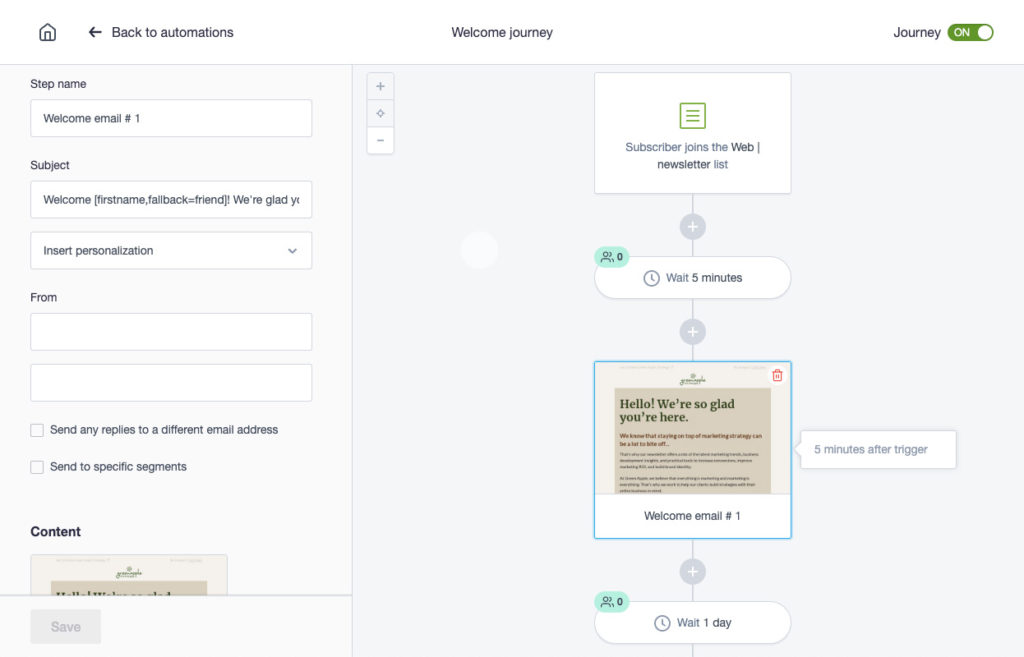If there’s one marketing channel that doesn’t get enough love, it’s the humble email newsletter. It’s not flashy like social media. It doesn’t promise instant leads like digital ads. But it works.
For small to mid-size B2B businesses, a well-done newsletter just might be your most underutilized tool for staying top of mind, building trust, and driving real business results.
In this post, we’re unpacking why newsletters deserve a front-row seat in your marketing strategy, how to get one off the ground quickly, and how to make your email newsletter better over time.
Why an Email Newsletter Should Be at the Core of Your Marketing Strategy
When someone signs up for your newsletter, they’re raising their hand and saying, “Yes, I want to hear from you.” That’s a rare and valuable thing in today’s attention economy.
Unlike social media, where visibility depends on algorithms and timing, email is an owned channel. That means you control the message and the delivery. When it’s done well, a newsletter builds trust, demonstrates expertise, and keeps you top of mind week after week and month after month.
For relationship-driven industries like construction, consulting, or B2B services, this is gold. Because when a prospect is ready to make a decision, they’re going to think of the company that’s been consistently showing up with something useful to say.
5 Simple Steps to Launch a B2B Newsletter
The key is to start simple, collect your results, and improve over time. Here’s how:
1. Don’t Overthink It—Just Start
The fastest way to figure out what works is by sending your first few issues and listening to the feedback. You can always pivot and adjust as you go.
2. Define The Value
Ask yourself: Who is this for? What one problem will it help them solve? It’s helpful to be very specific about your target audience and get clear on why they’ll want to read your content every time it hits their inbox. Ask these questions every time you’re brainstorming content for your newsletter.
3. Build a Repeatable Structure
Most effective email newsletters have a consistent framework—usually 3–5 short sections that can be read in under five minutes. If you’re struggling to come up with ideas, take inspiration from newsletters you personally enjoy. What do you like about them? What makes you open and read them consistently?
4. Choose a Frequency that Fits
How do you stay top of mind without becoming “white noise?” There’s no one-size-fits-all answer here. Start with monthly or every other week. You can always increase frequency as you gain traction and capacity.
5. Consider Segmentation as You Grow
If your audience includes different personas or industries, you might consider segmenting content down the line. More personalized emails tend to perform better, but not having a segmented email list shouldn’t stop you from starting.
How to Build and Grow Your Newsletter Subscriber List
A great email newsletter is only effective if people see it. Here are a few ways to build momentum:
1. Announce Your Arrival (Early and Often)
Don’t wait until your first newsletter is published to start talking about it. Reach out to your existing email list with a personal, concise note announcing your new venture. Explain what your newsletter will offer and why they should subscribe.
2. Craft Compelling Newsletter Capture Pages or Pop-Ups
You need a dedicated way for people to sign up for your newsletter—whether that’s a dedicated landing page or a pop-up window on your website. This makes it easy for your audiences to understand the benefits and subscribe. As you build it, aim for a conversion rate of at least 50% by clearly articulating the value proposition and focusing on your audience’s needs.
3. Optimize Your Digital Real Estate
Make subscribing a breeze across your website and social media platforms. Include clear and compelling calls-to-action in multiple locations, including your website footer, blog sidebars, contact pages, and even pinned posts on social media. Don’t make people hunt for the sign-up form!
4. Tease and Tempt with Pre-and Post-Newsletter CTAs
One effective way to cross-promote your newsletter is to give your social media followers a sneak peek of the valuable content dropping in your newsletter about 24 hours before it’s sent. A “teaser” can be a highly effective way to convert social followers into loyal subscribers.
5. Offer Irresistible Lead Magnets
Create valuable, downloadable resources (e.g., checklists, templates, guides) that require newsletter signup to access. Aim to create a new lead magnet once a month or once a quarter to continuously attract new subscribers who are interested in your expertise.
Creative Ways to Improve Your Email Newsletter Engagement
Once you’ve built a rhythm for distributing your newsletter, here are a few tactics that help you look for ways to make it even better:
1. Dive into the Data (Beyond Opens and Clicks)
While open and click-through rates are important, digging deeper into metrics can improve your overall content strategy. Implement creative ways to gather qualitative feedback. Include polls or short surveys at the bottom of your newsletters to understand what your audience truly enjoys and finds valuable.
2. Listen to Your Social Cues
Your social media content also provides a fantastic, real-time feedback loop. Pay attention to which topics and formats resonate most with your audience on social. Collecting this information can give you valuable insights into what content your newsletter subscribers might also find engaging.
3. Remember: Engagement Fuels Everything
The more engagement you generate through your newsletter, including replies, forwards, and shares, the more effective it will be in nurturing your audience’s attention and ultimately transitioning them into valuable leads and customers.
Ready to Start Your Newsletter?
If you’re thinking about starting a newsletter or revamping one that’s gone stale, now is the time. It doesn’t have to be perfect—it just has to be useful, consistent, and authentic to your brand.
Need some inspiration?
If you need a few ideas to get started, check out The Core, Green Apple’s monthly newsletter filled with marketing tips, resources, and strategies designed to help growing businesses get smarter and stronger.
Ready to start or scale your newsletter strategy? Let’s talk about how our team at Green Apple Strategy can help.











